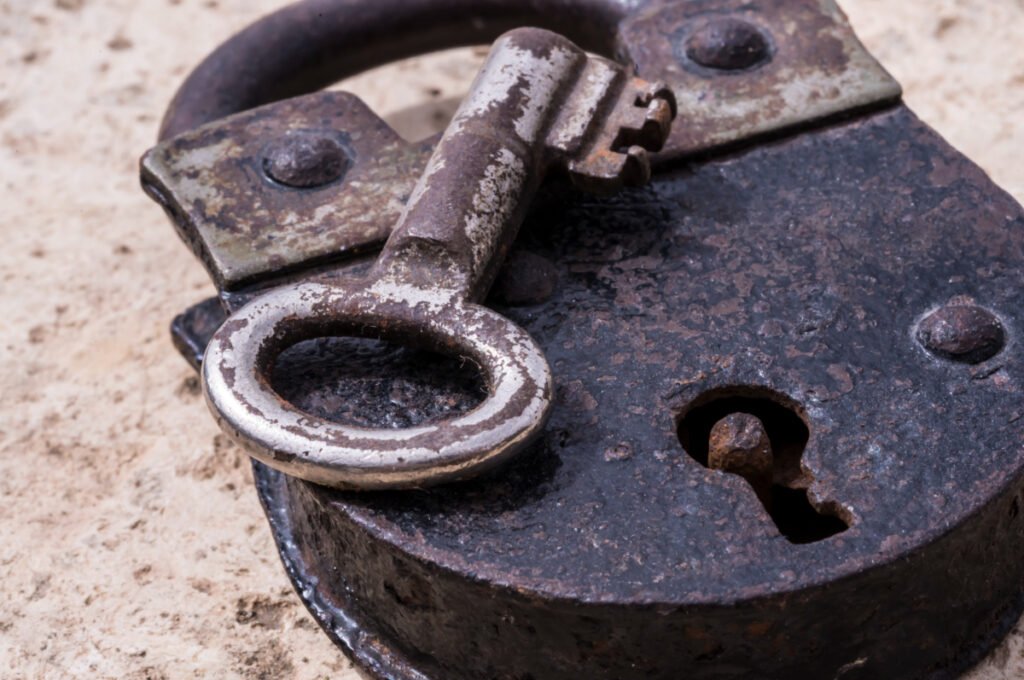We all need strong and secure locks for our homes and doors, right? And today, it’s all electrical and digital! But back in the old times, we had more variety! Take antique padlocks, for example! They had so many rare carvings, making them worth more than you think!
Now, you don’t see a padlock every day. So, your dealers might not know much about them. They might overlook the details or scam you for low returns. So today, I’ll help you know your padlock’s features and worth for the best returns! Let’s start the value guide, shall we?
Key Takeaways
- Ancient padlocks with handmade levers, pulleys, and shackles are the most precious. So, check for hammered, brushed, and hand-beaten finishes.
- Get old padlocks with cast iron, alloyed steel, or brass walls for high returns. Also, see for closed or long shackles.
- Pick rare or branded Asian, European, or Victorian padlocks for good value.
- You can get two types of antique padlocks – Combination or Steel cable. Of these, the combination ones are old and in demand.
How Do You Check If Your Padlock Is Old & Antique?

Remember, not every rusty padlock is antique! So, it’s better to check its pulling mechanism before buying one. For this, tension the shackle and position the pins. Next, get a magnet. If it sticks to the pins, you might have an old padlock worth $1000. If not, it might be new!
But if you don’t have a magnet nearby, here are other features to check:
- Push-key locks with a pull-down shackle and U-case
- Two press-fit plates to hold the cylinder in place
- Ball-bearing, Lever, or Pulley Locking system with abstract floral keys
- Cast-iron, Brass, or Alloyed walls with Yellow, Gray, or Brown tints
History & Evolution of Antique Padlocks
Well, experts still quarrel about the first antique padlock. Some say it’s from the Roman Empire, while others vote for Asia.
Well, the origin may be a subject of discussion, but we at Antiques Know How know that the first designs were thick, short, and double-cased. So, get these if you want a bid of $1000 – 2000.
It was in the 1800s that the makers added pins and springs to the locks. They also explored other precious metals like brass, silver, brass, and bronze. So, these padlocks were light, branded, and composite! Plus, they came in different colors, like yellow, gray, and brown.
The next 1900s era was a bit complex! Like, people wanted more fancy French and Scandinavian locks. So, makers used molds to boost production! But now every lock looked the same and had no hand touch. So, these will be relatively cheaper!
2 Types of Antique Pad Locks & Their Valuation
Padlocks certainly have fewer types than other hardware tools like old anvils and wrenches. But we can still divide them into two types based on their keys.
1. Combination Padlock

Ever seen the numeral locks on travel bags? Well, combination padlocks look the same! It’s just that they have wheels instead of numbers. You’ll also notice their tall, 11-12 cm handles and oxidized black bodies. Plus, these are handmade and solid iron, costing $800 – 1000.
2. Steel Cable Padlocks

Steel cable locks are the usual hole and key padlocks you see in shops. They are flexible and have a variable length to fit properly. They also have grooved walls, levers, and pulleys. But, this increases their friction with time. So, they are a bit cheaper, up to $600.
6 Factors to Identify & Value Antique Pad Locks
Just as we saw, every pad lock’s base price changes with the keys and mechanism. But do you know that even its age and colors affect the total cost? Let’s see how!
1. Antique Pad Lock Date & Age

Not everyone wants carved and usable padlocks, right? So, if you love the crude, hand finishes, go for the 1700s models. But if you want polished, even-to-touch padlocks, get the 1800s ones. Those are composite too! So you won’t have to worry about rusting!
But the 1900s padlocks will be perfect if you want a usable, easy-to-maintain piece. It’s just that they won’t be unique, rare, or precious.
Now, here are some important features to date those rusty padlocks!
How Does a 1700s Pad Lock Look?
If your padlock looks squarish and has long, pointed slots, it must be a 1700s model. You’ll also find traces of oil or Shellac on its bases. They will also weigh more, say about 50 – 90 grams, without keys. Also, see if they have U-shaped bars, sliding shackles, and turnkeys.
If you see the above features, you can price your piece for $1500 – 2000. Otherwise, $800 – 1000 is good!
How to Check an 1800s Padlock?
The 1800s padlocks are composite! So, you’ll see hand-shaped bodies and handles. But, the pin-holes and carvings will be machine-made. Next, look for bumped heads, screwed faces, and rivets. Also, check if they have a shiny brass or bronze finish, costing $500 – 800.
How to Choose a 1900s Padlock?
Check if your padlock has thin steel walls, springs, and keyhole covers. If yes, it must be a 1900s padlock. You’ll also see small, curved handles and screws on its faces. Most also have stamped logos and patent numbers, valuing $100 – 200. So, tracking them is easy!
Here are some old padlock patent numbers for reference:
| Year | Age | Patent Number | Average Valuation |
| 1857 | 166 years | US18169A | $500 – 600 |
| 1900s | 123 years | 3974669 | $100 – 200 |
| 1900s | 123 years | US1718723A | $100 – 200 |
Get padlocks with religious inscriptions, hieroglyphics, or stamped symbols for an old, rare make.
2. Vintage Padlock Materials

Get an old hammer and strike it lightly on the padlock’s surface. Does it ring, or does it stamp? You might have a 1700s oak lock with metal pins if it absorbs the sound.
But, if it rings, you might have a medieval iron or brass one. And if it looks shiny, it’s steel or zinc, for sure!
Want to know the exact value of each padlock material? Check out the list below!
| Old Padlock Materials | Average Valuation |
| Oak or Beech body with Metal Pin / Tumbler | $1000 – 1200 |
| Cast Iron or Alloyed Steel | $600 – 900 |
| Brass, Tin, or Bronze | $1000 – 2000 |
| Carbides Steel, Copper, Zinc | $500 – 600 |
| Stainless or Galvanized Steel | $100 – 200 |
Avoid getting padlocks with satin, brushed, or temper-roll finishes, as those might be new and cheap.
3. Old Padlock Shackle Patterns

Old padlocks have four types of shackles – straight, closed, round, and long. Of these, the closed and long ones are u-shaped and cased. So, they are thick, durable, and costly, up to $600. In contrast, the round or straight ones are new and thin, costing up to $400.
But how do you identify your padlock’s shackle? Well, just unpin the lock, and observe its bars. If they are short and u-shaped, it’s a closed shackle; if it’s parallel, it’s a straight shackle. And if the bar’s spherical, it’s a round one!
Next, measure the shackle’s length. If it’s more than 50 mm, you have a long shackle. But if the bar’s short, you have a regular one.
Pick locks with at least 10-12 mm wide shackles for a rare, handmade finish.
4. Antique Padlock Brands

Do you want a shortcut to identify and value your padlocks? Just rotate it, and check for any stamped logos or maker marks on the surface. And if you see some, it must be an 1800s branded padlock. Now, you just need to refer to the company’s brochure for the resale price!
Here are some easy-to-collect but precious padlock brands for reference:
| Old Padlock Name | Manufacturer | Estimated Manufacturing Year | Average Valuation |
| Excise Custom Big Original Padlock | Hobbs & Co London | 1900 – 1910 | $3500 – 3800 |
| Signal Box Padlock | Miller N.Y.C.R.R. | 1914 | $300 – 400 |
| York Padlock | Slaymaker | 1900s | $100 – 200 |
| Keyless, Bronze Padlock | American Lock Co. | 1900s | $100 – 150 |
Avoid getting chipped, cracked, broken, or rusty padlocks, as those might lose their value by 10 – 15%.
5. Old Padlock Colors

If you want an old, $800 – 1000 value padlock, get the bare metal or wood one. If you want polished, rust-free ones, get the oxidized white and black pieces.
But, if you want them colored, like a red, blue, and yellow vintage padlock, pick the hand-painted ones. It’s just that they’ll be cheaper.
6. Antique Padlock Styles

Surprisingly, padlock makers were all around the globe. So, each antique padlock obviously has some regional features. For example, the French ones are minimal, while the Chinese locks have carvings.
But it’s not just about the carvings! You can even get rare, lion or duck-shaped locks in the Victorian collection. So, each of these raises the cost by about 4 – 5%.
And here’s a list to help you pick the best padlock style!
| Old Padlock Style | Average Valuation |
| Victorian or Baroque | $130 – 200 |
| Imperial or European | $250 – 300 |
| Asian or Chinese | $300 – 350 |
| Russian Style | $130 – 150 |
Apply WD-40 lubes or regular greasers to remove the rust and check the inscriptions properly.
What Lubricant Should You Use on Antique Padlocks?
Dry lubricants like graphite powders or WD-40 lubes work best for antique padlocks. But you can even use regular vegetable oil or grease if you don’t have dry ones.
How Do You Open a Stuck, Antique Padlock?
You can open a stuck padlock with sharp devices like old knives and wrenches. Simply insert the pointed end inside the keyhole, and push the pins to open the shackle.
How Do You Clean Antique Padlocks?
You can clean antique padlocks with any carbonated liquids like vinegar, soda, or even Coca-Cola. Just rinse the lock carefully and rub it with a soft-bristled toothbrush. Next, dab some paper towels and leave them under a blower for drying.
It’s true that you won’t get good returns just for any padlock. For that, you must analyze their style, colors, age, and materials correctly. Hopefully, our guide has given you some insight to do the same. So, just clean the lock, know its top features, and resale or store it!
Moreover, you can also use antique padlocks to secure old trunks, dressers, and safes. It’s just that you must keep its keys properly!
Note: This article is intended for informational, educational, and entertainment purposes only. Some images are illustrative and may not represent actual brands, products, or related entities. All trademarks, product names, brand logos, packaging, and other intellectual property referenced remain the exclusive property of their respective owners. Any brand mentions or references are provided solely for descriptive and educational context and do not imply any formal or commercial association.










